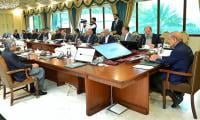This week will mark the inauguration of the Islamabad Security Dialogue, the culmination of years of advocacy and argument for a more coherent and cogent Pakistani national security narrative that aligns with the demographic and economic realities of the country and the region it is in: growth, connectivity and opportunity. The very fact that this dialogue is scheduled to take place represents a leap forward for how Pakistan frames and projects what it wants: from itself and from the world.
The architect of this coherence is General Qamar Javed Bajwa, but the vision that it represents is a more organic and more widely shared one. Shaheed Mohtarma Benazir Bhutto’s speeches and statements on the issues date back to the late 1980s. Even in his first term as prime minister, Nawaz Sharif was able to identify the prickly elements of Pakistan’s engagement with the Mujahideen and Afghan reconciliation. Prime Minister Imran Khan has been proven to be prescient in terms of his argument for dialogue as the only way forward in Afghanistan.
In short, a peaceful Pakistan that serves as connective tissue for the civilisational and economic transactions that will shape Central and South Asia for the next half century or more is an issue of wide political consensus in Pakistan. The Islamabad Security Dialogue should therefore be a moment of celebration, across political and social divides. As we will see this week, however, there will be a lot of criticism of the Dialogue, and its organizers. A lot of this will be unfair, personalized mudslinging.
There is no shortage of PM Khan’s own detractors, no shortage of critics of the armed forces and their role in what should be civilian-led thought exercises, and of course, no shortage of people who hate to see a highly qualified professional serve in government in the shape of Moeed Yusuf. But there is some criticism of the Islamabad Security Dialogue that can and should be heard, and heeded.
At the heart of the big Pakistani transition, from engaging in geopolitical gamesmanship to aligning with geoeconomic opportunity is not whether Beijing or Washington DC or Moscow are happy with Pakistan or not. At the heart of this transition is one thing, and one thing alone: better lives for Pakistanis. Can better lives for Pakistanis be a product of a vision that is driven from the desks and boardrooms of Islamabad and Rawalpindi, with no concern for Pakistani voices, even problematic ones? Especially problematic ones?
This isn’t just a question for Rawalpindi, or Aabpara, or PM Khan alone. This is also a question for London and Raiwind, a question for Dubai and Shaheed Benazirabad and Karachi, and a question for the Pakistan Stock Exchange, the Pakistan Business Council, the All Pakistan Textile Mills Association, the Pakistan Sugar Mills Association, and the Secretaries’ Committee. Can top-down, bottom-damned ‘consensus’ be sustained in Pakistan? For how long?
The history of finely engineered consensus in Pakistan is not great. Time after time after time, every meticulously designed grand bargain that deliberately demonizes or excludes stakeholders deemed unnecessary, eventually collapses. Maybe the best example of this is “the unassailable Nawaz Sharif of spring 2016” – exactly five years ago.
In the spring of 2016, Nawaz Sharif had a friendly army chief who had busied himself with winning the ‘war on terror’. Nawaz was presiding over an economy that had grown at 4.7 percent the year before and was set to cross 5.5 percent that year. He had political capital that had accrued to him from the failed PTI dharna of 2014. Most of all, he had no clear political challengers. Enter the Panama Papers and the subsequent meltdown: internally, the House of Sharif’s sense of panic, and externally a joining of forces among all those that Sharif had vanquished en route to “the unassailable Nawaz Sharif of spring 2016”. But was it really the Panama Papers that did Nawaz Sharif in?
The Dawn Leaks story of a rift between civilian and military authorities had created both a problem of perception and of management. Internally, the army faced a growing chorus of officer anger. Externally, Pakistan faced a building momentum of India’s machinations to handcuff and hamstring the country economically and politically.
Between these rocks and hard places, were stuck the military and civilian heads. ‘The unassailable Nawaz Sharif of spring 2016’ had already given way to something less certain. A working equilibrium had to be found: a happy middle in which the public wounds would be healed, and Pakistan could get back to growing at 5.5 percent, maybe 6 percent – (maybe even 7 percent, 8 percent or 9 percent?).
The negotiations for achieving this happy medium did not go well. Twitter has ruined many a good brain, incentivizing the rushes of 140-character bursts of emotion and anger over reasoned and dispassionate engagement. Perhaps no greater example of this was THAT tweet. The suddenly less lustrous Nawaz Sharif of fall 2016 gave way to angry and stubborn Nawaz Sharif circa 2017, which produced the jailbird Nawaz Sharif circa 2018. Over two and a half years later, and the sliding doors of Pakistan make for some seriously whiplashed necks and brains.
What if?
Alas, path dependency, inertia, disruption and momentum are all real, all at the same time. If you are banking too much on what you know based on ‘what is’ rather than ‘what could be’, then you go from unassailable to in-jail in less than two years. But what if you are banking too much on ‘what happened’, instead of ‘what could be happening’? What is the path forward for PM Khan and the wider notion of the one page of civil-military alignment?
Sadly, at least for those that dislike compromise, and are uncomfortable with grey and prefer only the black and white that suits them, there is only one way forward. Luckily, for those that believe in true coherence and national harmony, that one way forward is dialogue. A dialogue between those that have power and those that seek power. A dialogue between those that are at the center and those that are at the periphery. A dialogue between those that claim all is well and those that claim that all is ruined. A dialogue between have and have-nots, capitalists and labour, rulers and the ruled, and the content and discontents.
One of the reasons a domestic dialogue, the so-called grand national dialogue that I and many others had argued for throughout the autumn of 2020, is so important is because Pakistan faces a unique and unprecedented opportunity beyond its borders.
Afghanistan is not destined to handcuff and straitjacket Pakistan unconditionally or permanently. The proof is the substantial changes in Pakistan’s approach to Afghanistan. I wrote about the principal contradiction in Afghanistan that Pakistan must cater to and plan for in this space on November 6, 2019. Less than 18 months since, much of the Pakistani state narrative has aligned with, adapted and adopted the language of geoeconomics and demographic security, as far as Afghanistan and the region is concerned. The Islamabad Security Dialogue is a validation and affirmation of this major change – one which must be acknowledged and welcomed.
The only obstacle now between articulating and achieving this brave new economy-first vision is for Pakistan to engage with and tackle its principal contradiction here at home. It can be done. But individual ambition and egos need to be put aside to do so. We have witnessed how Nawaz Sharif’s failure to do so has undermined Pakistani progress. Wise men and women must learn from the experience of their predecessors. Dialogue abroad and dialogue at home. It is the only way forward for Pakistan.
The writer is an analyst and commentator.
A woman walks past a building of the International Monetary Fund. — AFP/FileThe annual and spring meetings of the...
Late Benazir Bhutto's daughter Asifa Bhutto Zardari addresses the Christian community in Bihar Colony on January 23,...
Representational image. — PexelsWater is an important scarce natural resource that is required for several everyday...
Pakistani employees of online marketplace company Kaymu at work in Karachi. — AFP/FileThe true spirit of development...
India uses Afghanistan as a backstage area to carry out terrorist attacks against Pakistan
Another report by the Pakistan Institute of Peace Studies states that 78 per cent of attacks have been carried out by...







